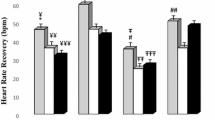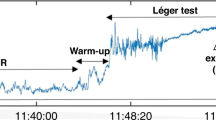Abstract
Purpose
This investigation was carried out to study the relationship between resting heart rate variability (HRV) and heart rate recovery (HRR) after upper body exercise test (arm cranking) in some healthy men with different ages.
Methods
Thirty-six healthy men (children n = 12, adult n = 12, elderly n = 12) performed an incremental upper body exercise testing on an arm ergometer. HRV was obtained via an ECG during rest. HRR was reported as the reduction in heart rate from the peak exercise to the heart rate 2 min after cessation of exercise.
Results
In children, resting standard deviation of normal RR intervals (SDNN) and root mean square of sequential deviations (RMSSD) were significantly correlated with heart rate recovery two min after cessation of exercise (r = 0.809, P = 0.003 and r = 0.719, P = 0.13, respectively). In contrast, there was no significant relationship between resting HRV parameters and HRR2 in the adult and elderly groups.
Conclusions
The results of this investigation suggested that in children HRR2 in early stages after upper body exercise was related to basal parasympathetic modulation. Further studies are needed to identify and document the effect of various physical activities on autonomic cardiovascular health in different ages.


Similar content being viewed by others
References
Tonello L, Rodrigues FB, Souza JW, Campbell CS, Leicht AS, Boullosa DA (2014) The role of physical activity and heart rate variability for the control of work related stress. Front Physiol 5:67. doi:10.3389/fphys.2014.00067
Cole CR, Blackstone EH, Pashkow FJ, Snader CE, Lauer MS (1999) Heart-rate recovery immediately after exercise as a predictor of mortality. N Engl J Med 341:1351–1357
Esco MR, Olson MS, Williford HN, Blessing DL, Shannon D, Grandjean P (2009) The relationship between resting heart rate variability and heart rate recovery. Clin Auton Res 20:33–38. doi:10.1007/s10286-009-0033-2
Imai K, Sato H, Hori M, Kusuoka H, Ozaki H, Yokoyama H, Takeda H, Inoue M, Kamada T (1994) Vagally mediated heart rate recovery after exercise is accelerated in athletes but blunted in patients with chronic heart failure. J Am Coll Cardiol 24:1529–1535
Mendonca GV, Pereira FD, Fernhall B (2013) Heart rate recovery and variability following combined aerobic and resistance exercise training in adults with and without Down syndrome. Res Dev Disabil 34:353–361
Jae SY, Heffernan KS, Lee M, Fernhall B (2011) Relation of heart rate recovery to heart rate variability in persons with paraplegia. Clin Auton Res 21:111–116. doi:10.1007/s10286-010-0096-0
Task Force of the European Society of Cardiology and the North American Society of Pacing and Electrophysiology (1996) Heart rate variability: standards of measurement, physiological interpretation and clinical use. Circulation 93:1043–1065
Vuksanovic V, Gal V, Kalanj J, Simeunovic S (2005) Effect of posture on heart rate variability spectral measures in children and young adults with heart disease. Int J Cardiol 101:273–278
Myllymäki T, Rusko H, Syväoja H, Juuti T, Kinnunen ML, Kyröläinen H (2012) Effects of exercise intensity and duration on nocturnal heart rate variability and sleep quality. Eur J Appl Physiol 112:801–809
Leti T, Bricout V (2013) Interest of analysis of heart rate variability in the prevention of fatigue states in senior runners. Auton Neurosci 173:14–21
Bilchick KC, Fetics B, Djoukeng R, Fisher SG, Fletcher RD, Singh SN, Nevo E, Berger RD (2002) Prognostic value of heart rate variability in chronic congestive heart failure: veterans affairs’ survival trail of antiarrhythmic therapy in congestive heart failure. Am J Cardiol 90:24–28
Dekker JM, Crow RS, Folsom AR, Hannan PJ, Liao D, Swenne CA, Schouten EG (2000) Low heart rate variability in a 2-minute rhythm strip predicts risk of coronary heart disease and mortality from several causes: the ARIC study. Atherosclerosis risk in communities. Circulation 102:1239–1244
Liao D, Carnethon M, Evans GW, Cascio WE, Heiss G (2002) Lower heart rate variability is associated with the development of coronary heart disease in individuals with diabetes: the atherosclerosis risk in communities (ARIC) study. Diabetes 51:3524–3531
Clausen JP (1976) Circulatory adjustments to dynamic exercise and effect of physical training in normal subjects and in patients with coronary artery disease. Prog Cardiovasc Dis 18:459–495
Miles DS, Cox MH, Bomze JP (1989) Cardiovascular responses to upper body exercise in normal and cardiac patients. Med Sci Sport Exerc. 21:126–131
Pendergast DR (1989) Cardiovascular, respiratory, and metabolic responses to upper body exercise. Med Sci Sport Exerc. 21:122–125
Danieli A, Lusa L, Potočnik N, Meglič B, Grad A, Bajrović FF (2014) Resting heart rate variability and heart rate recovery after submaximal exercise. Clin Auton Res 24:53–61. doi:10.1007/s10286-014-0225-2
Evrengul H, Tanriverdi H, Kose S, Amasyali B, Kilic A, Celik T, Turhan H (2006) The relationship between heart rate recovery and heart rate variability in coronary artery disease. ANE 11:154–162
Nunan D, Jakovljevic DG, Donovan G, Singleton LD, Sander-cock GRH, Brodie DA (2010) Resting autonomic modulations and the heart rate response to exercise. Clin Auton Res 20:213–221
Javorka M, Zila I, Balharek T, Javorka K (2002) Heart rate recovery after exercise: relations to heart rate variability and complexity. Braz J Med Biol Res 35:991–1000
Bosquet L, Gamelin FX, Berthoin S (2007) Is aerobic endurance a determinant of cardiac autonomic regulation? Eur J Appl Physiol 100:363–369
Heffernan KS, Fahs CA, Shinsako KK, Jae SY, Fernhall B (2007) Heart rate recovery and heart rate complexity following resistance exercise training and detraining in young men. Am J Physiol Heart Circ Physiol 293:3180–3186
Evrengul H, Tanriverdi H, Kose S, Amasyali B, Kilic A, Celik T, Turhan H (2006) The relationship between heart rate recovery and heart rate variability in coronary artery disease. Ann Noninvasive Electrocardiol 11:154–162
Guilkey JP, Overstreet M, Fernhall B, Mahon AD (2014) Heart rate response and parasympathetic modulation during recovery from exercise in boys and men. Appl Physiol Nutr Metab 39:969–975
Uth N, Sorensen H, Overgaard K, Pedersen PK (2004) Estimation of VO2max from the ratio between HRmax and HRrest—the heart rate ratio method. Eur J Appl Physiol 91:111–115
Rajendra U, Joseph K, Kannathal N, Lim CM, Suri JS (2006) Heart rate variability: a review. Med Bio Eng Comput 44:1031–1051
Sugawara J, Murakami H, Maeda S, Kuno S, Matsuda M (2001) Change in post-exercise vagal reactivation with exercise training and detraining in young men. Eur J Appl Physiol 85:259–263
Muraki S, Tsunawake N, Yamasaki M (2004) Difference in cardiac autonomic control between steady-state arm cranking and leg cycling in women. Adv Exerc Sports Physiol 10:93–99
Marcus B, Gillette PC, Garson A (1990) Intrinsic heart rate in children and young adults: an index of sinus node function isolated from autonomic control. Am Heart J 119:911–916
Lu HH, Lange G, Brooks CM (1965) Factors controlling pacemaker action in cells of the sinoatrial node. Circ Res 17:460–471
Ohuchi H, Suzuki H, Yasuda K, Arakaki Y, Echigo S, Kamiya T (2000) Heart rate recovery after exercise and cardiac autonomic nervous activity in children. Pediatr Res 47:329–335
Leti T, Bricout V (2013) Interest of analysis of heart rate variability in the prevention of fatigue states in senior runners. Auton Neurosci 173:14–21
Sushant MR, Christopher AF, Huimin Y, Lindy MR, Stamatis A, Bo F (2011) Heart rate recovery following maximal arm and leg-ergometry. Clin Auton Res 21:117–120
Acknowledgments
The authors would like to thank the College of Physical Education and Sport Sciences, Department of Sport Physiology, University of Mazandaran, Babolsar, Iran, for their collaboration in this work.
Conflict of interest
The authors declare no conflict of interest.
Author information
Authors and Affiliations
Corresponding author
Rights and permissions
About this article
Cite this article
Ahmadian, M., Dabidi Roshan, V. Heart rate recovery following arm cranking is positively associated with resting heart rate variability in children. Sport Sci Health 11, 153–157 (2015). https://doi.org/10.1007/s11332-014-0215-8
Received:
Accepted:
Published:
Issue Date:
DOI: https://doi.org/10.1007/s11332-014-0215-8




